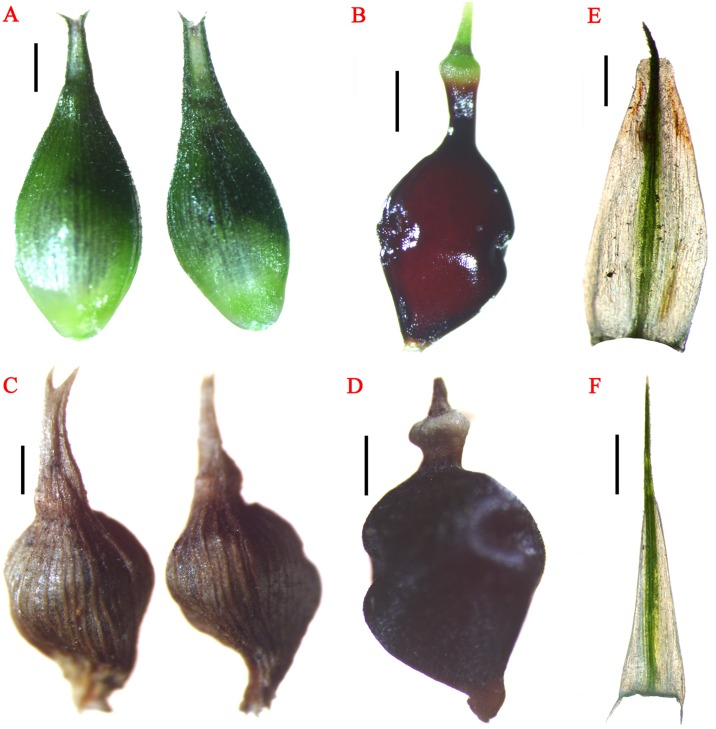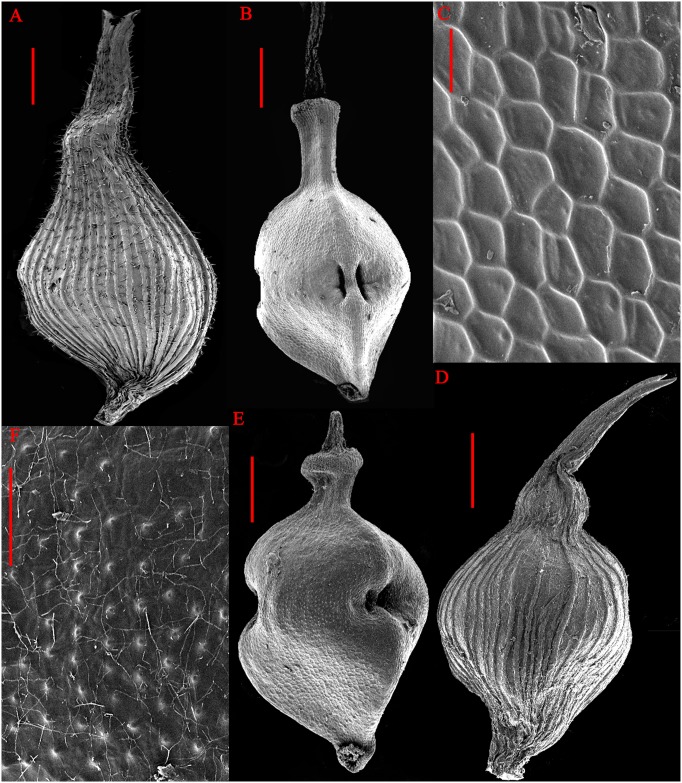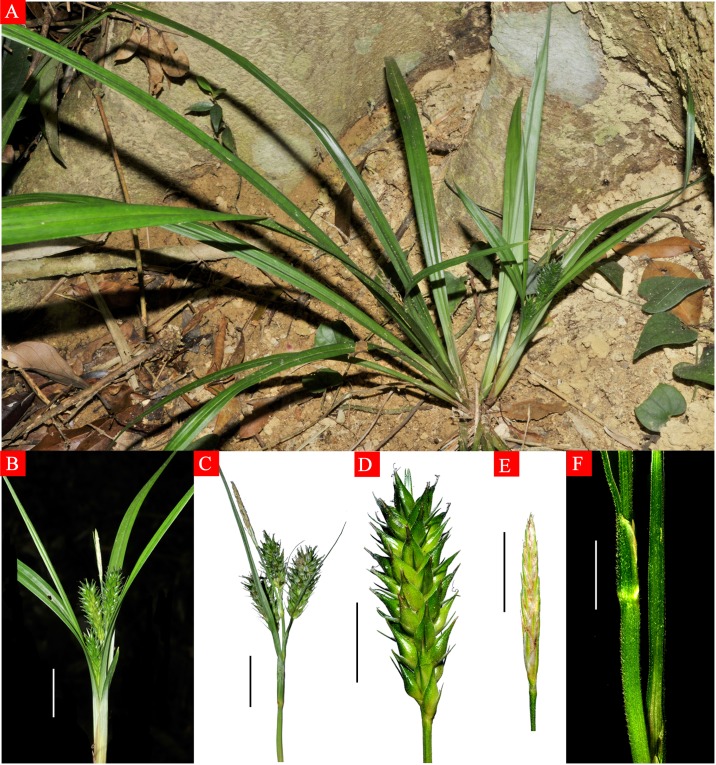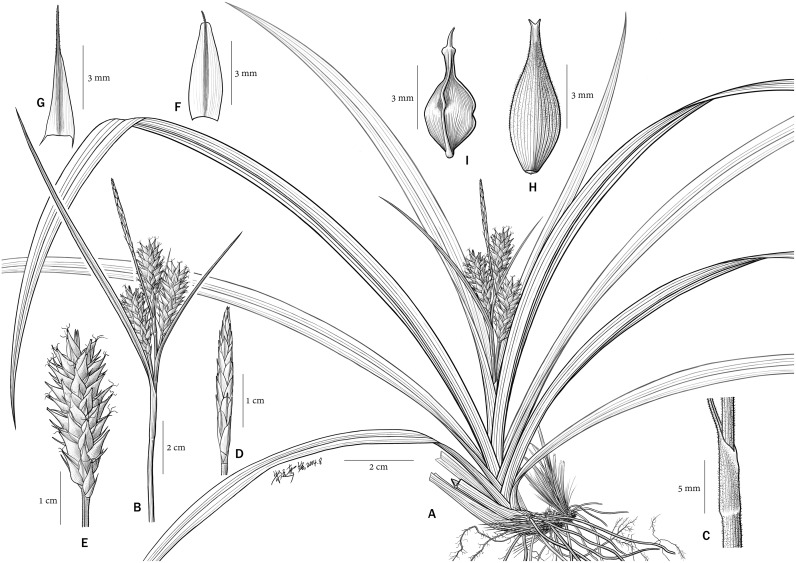Abstract
A new species of Carex sect. Rhomboidales, C. jianfengensis, is described and illustrated from Hainan, China. The new species is similar to C. zunyiensis but differs in having involucral bracts sparsely hispid and with ca.1 cm long sheaths; inflorescence with 4 spikes, terminal spike ca. 2.5 cm long, lateral spikes 2–3.5 × 0.7–1 cm; staminate glumes narrowly ovate, ca. 5 mm; pistillate glumes triangular-lanceolate, 5–7 mm; perigynia 6–8 × 3 mm and pubescent on veins; nutlet 4–5 mm long, rhombic-ovoid, trigonous, base with shortly stipitate, apex abruptly contracted into a erect short beak, and not expanding into an annulate orifice.
Introduction
The genus Carex L. is one of the largest genera of vascular plants, comprising about 2,000 species distributed almost worldwide in various habitats[1–5]. 527 species in three subgenera and 69 sections were recorded in recently published Flora of China. Recently, additional 18 species have been reported[6–18].
The genus Carex is clearly distinguished from other genera of the Cyperaceae in having consistently unisexual flowers and a perigynium, the latter a sac-like structure of prophyllar origin that surrounds the naked gynoecium[19]. Carex has been divided into subgenera in a number of ways based on the following characters: stigma number, inflorescence structure and distribution of staminate and pistillate flowers within the spikes. The most influential classification was that of Georg Kükenthal who recognized four subgenera: Carex subg. Carex, C. subg. Indocarex, C. subg. Vignea and C. subg. Primocarex. Subsequently, C. subg. Indocarex and C. subg. Primocarex were reclassified as C. subg. Vigneastra [20]. This classification was widely followed by most authors[2,21–25].
Carex sect. Rhomboidales belongs to C. subg. Carex and is characterized by long-sheathing bracts with short blades, trigonous, rhombic to ovoid perigynia with columniform bidentate beaks at the apex, and obovoid or ovoid, trigonous nutlets that are constricted in the middle part and mitrate or hastate at the apex[5,20]. The section consists of 41 species, mainly distributed in eastern Asia, with 36 species being native to China and 4 species in Hainan Island. [2, 7–9,11–14,16, 21,26–28,]. Hainan Island is located at the southern part of China, at the northern edge of tropical Asia, with about 4 100 vascular plant species. To date, 27 species of Carex have been reported from Hainan[6,14–16,29,].
During an investigation of the flora of Jianfeng Ling Nature Reserve in 2014, a novel species of Carex was collected and is here recognized as a new species in sect. Rhomboidales. Morphologically, the new species has affinities with Carex zunyiensis Tang & F.T. Wang.
Materials and Methods
Ethics statement
The new species reported in this work is collected from Jianfeng Ling Nature Reserve which is protected by the Forestry Bureau of Hainan. Permissions to visit location and field activities were obtained from Jianfeng Ling Nature Reserve Administration Bureau.
Morphological observations
The morphological description is based on examination of fresh and dried specimens. Details of the staminate terminal spike, the pistillate lateral spikes, the pistillate glume, the perigynium and the nutlet were examined and photographed under a stereomicroscope (Olympus SZX16-6156). The shapes of perigynium and nutlet were observed using a Philips XL-30E scanning electron microscope. The studied specimens (one holotype, four isotypes, two paratypes) were deposited in the herbaria of the South China Botanical Garden, the Chinese Academy of Sciences (IBSC), and the Tropical Crops Genetic Resources Institute, Chinese Academy of Tropical Agricultural Sciences (TCGRI; not listed in Thiers 2008[30]).
Nomenclatural Acts
The electronic version of this article in Portable Document Format (PDF) in a work with an ISSN or ISBN will represent a published work according to the International Code of Nomenclature for algae, fungi, and plants, and hence the new names contained in the electronic publication of a PLOS ONE article are effectively published under that Code from the electronic edition alone, so there is no longer any need to provide printed copies.
In addition, new names contained in this work have been submitted to IPNI, from where they will be made available to the Global Names Index. The IPNI LSIDs can be resolved and the associated information viewed through any standard web browser by appending the LSID contained in this publication to the prefix http://ipni.org/. The online version of this work is archived and available from the following digital repositories: PubMed Central, LOCKSS.
Results
The new species is most similar to C. zunyiensis based on the shape of the leaves, the very short culms and the subbasal and approximate spikes, but differs sufficiently to be recognized as a new species in morphological features (Table 1, Figs 1 and 2).
Table 1. Morphological comparison between Carex jianfengensis and C. zunyiensis.
| Character | C. jianfengensis | C. zunyiensis |
|---|---|---|
| Sheaths | 2−7 cm long and with purple vertical stripes | basal ones dark brown disintegrating into fibers, upper ones slightly scabrous on the margin |
| Bracts | sparsely hispid and with ca. 1 cm long sheaths | glabrous, sheathless |
| Inflorescence | spikes 4 and occasionally 1 lateral spike arising from the culm base | spikes 4−7 |
| Spikes | terminal spike ca. 2.5 cm long; lateral spikes 2−3.5 cm long | terminal spike 3.5−5 cm long; lateral spikes 3−5 cm long |
| Glumes | staminate glumes narrowly ovate; pistillate glumes triangular-lanceolate, 5−7 mm long, green 1-veined, costa excurrent into a short awn ca. 2 mm long | staminate glumes lanceolate; pistillate glumes lanceolate, ca. 4 mm long, 3-veined, costa excurrent into a scabrous mucro at sharp apex |
| Perigynia | 6−8 mm; densely hispid | 4−5 mm; sparsely hispid |
| Nutlets | rhombic-ovoid, with angles constricted at the middle, base shortly stipitate, apex abruptly contracted into an erect short beak and not expanding into an annulate orifice; epidermal cells with irregularly 4-5-gonal, central no silica body | ovate-elliptic with angles constricted above, apical beak short, curved, expanding into an annulate orifice; epidermal cells with irregularly 5-6-gonal, central with 1 silica body |
Fig 1. Carex jianfengensis A. Perigynia, B. Nutlet, E. Staminate glume, F. Pistillate glume; C. zunyiensis C. Perigynia. D. Nutlet. (C. zunyiensis from IBSC).
Scale bars = 1 mm.
Fig 2. Carex jianfengensis A. Perigynium, B. Nutlet, C. Surface sculpturing; C. zunyiensis D. Perigynium, E. Nutlet, F. Surface sculpturing. (C. zunyiensis from IBSC).
Scale bars: A. B. D. E = 1 mm; C = 50 um; F = 100 um.
Taxonomic Treatment
Carex jianfengensis H.B. Yang, X.X. Li & G.D. Liu sp. nov. (Figs 1–4)
Fig 4. Carex jianfengensis A. Habit, B. Inflorescence, C. Inflorescence, D. Lateral pistillate spike, E. Terminal staminate spike, F. Bract sheaths.
Fig 3. Carex jianfengensis A. Habit; B. Inflorescence; C. Bract sheaths; D. Terminal staminate spike; E. Lateral pistillate spike; F. Staminate glume; G. Pistillate glume; H. Perigynium; I. Nutlet.
The new species is similar to C. zunyiensis, but differs by having sparsely hispid involucral bracts and sheaths, inflorescence with 4 spikes and occasionally 1 lateral spike arising from the culm base,terminal spike ca. 2.5 cm long, lateral spikes 2–3.5 × 0.7–1 cm, staminate glumes narrowly ovate, ca. 5 mm long, truncate at apex, green 3-veined costa excurrent into a short awn ca. 0.6–0.8 mm long, pistillate glumes triangular-lanceolate, 5–7 mm long, green 3-veined costa excurrent into a short awn ca. 2 mm long, perigynium 6–8 × 3 mm, nutlet rhombic-ovoid, base shortly stipitate, short beak erect and not expanding into an annulate orifice.
Type
—CHINA. Hainan: Ledong County, Jianfeng Ling Nature Reserve, under forest, alt. 700−900 m, 17 March 2014, Yang Hubiao 20140317001 (holotype, IBSC; isotype, IBSC; TCGRI three duplicates).
Perennial; rhizome short, covered with fibrous remains of old leaf sheath. Culms central, 2−4 × ca. 0.2 cm, significantly shorter than leaves, hiding in leaf sheaths, trigonous. Leaves basal, sheathed; blades linear, 25−65 × 1−1.6 cm, veins 3-ranked, green, flat, glabrous on both surfaces, apex acuminate; sheaths 2−7 cm long, with purple vertical stripes, basal ones bladeless. Involucral bracts slightly surpassing inflorescence, leaf-like, sparsely hispid, sheathed; sheaths ca. 1 cm long, sparsely hispid. Inflorescence of spikes racemose, with 4 spikes, approximate, occasionally 1 lateral spike arising from the culm base. Terminal spike staminate, trigonous-cylindrical, ca. 2.5 cm long; peduncle 2−3.5 cm long, sparsely hispid. Lateral spikes pistillate, cylindrical, 2−3.5 × 0.7−1 cm, densely flowered, with peduncle 1−3 cm long; occasionally peduncle up to 7 cm long when lowest lateral spike arises from the culm base. Staminate glumes membranous, glabrous, narrowly ovate, ca. 5 mm long, truncate at apex, green 3-veined costa excurrent into a short awn ca. 0.6−0.8 mm long; pistillate glumes triangular-lanceolate, 5−7 mm long, membranous, glabrous, green 3-veined costa excurrent into a short awn for ca. 2 mm. Perigynia longer than the glumes, green, oval, obscurely trigonous, 6−8 × 3 mm, membranous, distinctly veined, pubescent on veins, gradually contracted into a ca. 2 mm long beak; orifice 2-lobed with long teeth. Nutlets tightly enveloped, rhombic-ovoid, trigonous, 4−5 mm long, brownish-black, with angles constricted at the middle, base shortly stipitate, apex abruptly contracted into an erect short beak 1 mm long; persistent style, base thickened. Flowering and fruiting January to May.
Distribution and Habitat
Carex jianfengensis was collected from Jianfeng Ling Nature Reserve, Hainan, China. It grows under the tropical mountain rain forest at altitudes of 700–900 m. Associates include Polyspora hainanensis (H. T. Chang) C.X. Ye ex B.M. Barthol. & T.L. Ming, Schima superba Gardner & Champ., Alsophila spinulosa (Wall. ex Hook.) R.M. Tryon, Schizostachyum pseudolima McClure, Hypolytrum nemorum (Vahl) Spreng., Carex breviscapa C.B. Clarke, and Dianella ensifolia (L.) DC.
Phenology
Flowering occurs from January and usually seeds mature in March to May.
Etymology
The epithet “jianfengensis” refers to the type locality, Jianfeng Ling Natural Reserve.
Conservation status
So far, this species is known from only one population and comprises approximately 2800 caespitose individuals, covers an area of 1000 m2. According to the IUCN (2001) category and criteria, Carex jianfengensis is a vulnerable species (VU).
Relationships
The new species belongs to Carex sect. Rhomboidales. In Hainan Island, four species, C. harlandii Boott, C. saxicola Tang & F.T. Wang, C. longipetiolata Q.L. Wang, H.B. Yang & Y.F. Deng and C. procumbens H.B. Yang, X.X. Li & G.D. Liu have been reported[14,16]. In addition to the above, 5 new taxa from other regions have recently been described in sect. Rhomboidales: C. jubozanensis J. Oda & A. Tanaka, C. austrozhejiangensis C.Z. Zheng & X.F. Jin, C. kagoshimensis Tak. Shimizu, C. yandangshanica C.Z. Zheng & X.F. Jin and C. paracheniana X.F. Jin, D.A. Simpson & C.Z. Zheng[9,11–13,26]. However, C. jianfengensis can be easily distinguished from species mentioned above by its short culms less than 5 cm and its subbasal and approximate spikes. It is similar to C. zunyiensis based on the short culms, but differs have been mentioned in above Table 1.
Additional specimens examined (Paratypes)
CHINA. Hainan: Ledong County, Jianfeng Ling Nature Reserve, under forest, alt. 700−900 m, 15 April 2014, Yang Hubiao 20140415001 (two duplicates, TCGRI).
Acknowledgments
This research was financially supported by the Basic Scientific Research Business Expenses (1630032014030), the Earmarked Fund for China Agriculture Research System (CARS-35-03) and the project of tropical forage germplasm resources protection (14RZZY-09). We thank Dr. Yun-Fei Deng and Yi Tong (South China Botanical Garden of the Chinese Academy of Sciences, IBSC) for check herbarium. We are also grateful to Mr. Yu-xi Zhu for his help in preparing the line drawing and Schultze-Kraft Rainer (the International Center for Tropical Agriculture, CIAT) for improving the English.
Data Availability
All relevant data are within the paper.
Funding Statement
This research was financially supported by the Basic Scientific Research Business Expenses (1630032014030), the Earmarked Fund for China Agriculture Research System (CARS-35-03) and the project of tropical forage germplasm resources protection (14RZZY-09). The funders had no role in study design, data collection and analysis, decision to publish, or preparation of the manuscript.
References
- 1. Ball PW, Reznicek AA. Carex In: Ball PW, Reznicek AA, Murray DF. (eds.) Flora of North America: North of Mexico (vol 23). Oxford University Press, pp. 2003; 254–640. [Google Scholar]
- 2. Dai LK, Liang SY, Li PC, Tang YC. Carex (Cyperaceae-Carioideae) In: Dai LK, Liang SY.(eds.) Flora Reipublicae Popularis Sinicae 12 Science Press, Beijing: 2000; pp. 56–528. [Google Scholar]
- 3. Frodin DG. History and concepts of big plant genera. Taxon. 2004; 3: 753–776. [Google Scholar]
- 4. Nelmes E. The genus Carex in Malaysia. Reinwardtia.1951; 1: 221–450. [Google Scholar]
- 5. Ohwi J. Cyperaceae Japonicae I. A synopsis of the Caricoideae of Japan, including the Kuriles, Saghalin, Korea and Formosa. Memoirs of the College of Science, Kyoto Imperial University (ser.B). 1936; 11: 229–530. [Google Scholar]
- 6. Deng YF. Carex longicolla (Cyperaceae), a new sedge from China. Phytotaxa. 2014; 178(3): 181–188. [Google Scholar]
- 7. Jin XF & Zheng CZ. Taxonomy of Carex sect Rhomboidales (Cyperaceae).Science Press, Beijing: 2013; 237 pp. [Google Scholar]
- 8. Jin SH, Zhao YJ, Shen TT, Wu DF, Jin XF. Carex tenuirostrata (Cyperaceae), a new species of section Confertiflorae from Zhejiang, China. Brittonia. 2012a; 64: 325–329. [Google Scholar]
- 9. Jin XF, Simpson DA, Zheng CZ, Sun L, Zhang HW. Carex paracheniana (Carex sect. Rhomboidales, Cyperaceae), a new species from Guangxi and Guizhou, China. Syst Bot. 2012b; 37: 929–937. [Google Scholar]
- 10. Jin XF, Zhao YJ, Zheng CZ, Zhang HW. Carex zhejiangensis sp. nov. (Cyperaceae) from Zhejiang, eastern China. Nord J Bot 2011; 29: 63–70. [Google Scholar]
- 11. Jin XF, Zheng CZ. Carex yandangshanica sp. nov. (Cyperaceae; C. sect. Rhomboidales) from Zhejiang, China. Nord J Bot. 2010; 28: 709–712. [Google Scholar]
- 12. Jin XF, Zheng CZ, Ding BY. New taxa of Carex (Cyperaceae) from Zhejiang, China. Acta Phytotaxon Sin. 2004; 42: 541–550. [Google Scholar]
- 13. Shimizu T. Carex kagoshimensis, a new species of Carex (sect. Rhomboidales) from Japan. Acta Phytotaxonomica et Geobotanica. 2008; 59: 67–72. [Google Scholar]
- 14. Wang QL, Yang HB, Deng YF, Wang ZN, Liu GD. Carex longipetiolata (Cyperaceae), a new sedge from Hainan, China. Phytotaxa. 2012; 75: 65–69. [Google Scholar]
- 15. Yang HB, Wang QL, Bai CJ, Li X X, Liu GD. Carex diaoluoshanica (Carex sect. Lageniformes, Cyperaceae), a New Species from Hainan, China. PLoS ONE. 2014; 9(6): e97658 doi: 10.1371/journal.pone.0097658 [DOI] [PMC free article] [PubMed] [Google Scholar]
- 16. Yang HB, Li XX, Chang JB, Wang WQ, Wang QL, Yu DG, Dong RS. Liu GD. Carex procumbens (Carex sect. Rhomboidales, Cyperaceae), a new species from Hainan, China. Phytotaxa. 2015; 201(3): 207–213. [Google Scholar]
- 17. Yu LY, Huang YF, Xu WB, Deng YF. Carex trongii K. K. Nguyen, a newly recorded species of Cyperaceae from China. Journal of Tropical and Subtropical Botany. 2012; 20: 403–406. [Google Scholar]
- 18. Zhao YJ, Shen TT, Zheng Y, Chen ZL, Jin XF. Carex dapanshanica sp. nov. (C. sect. Mitratae, Cyperaceae) from Zhejiang, China. Nord J Bot. 2011; 29: 670–673. [Google Scholar]
- 19. Blaser HW. Studies in the morphology of the Cyperaceae. I. Morphology of flowers. II. The prophyll. Am J Bot 1944; 31: 53–64. [Google Scholar]
- 20. Kükenthal G. Cyperaceae Caricoideae In: Engler A. (ed.) Das Pflanzenreich IV. 20 Engelmann, Leipzig: 1909; 824 pp. [Google Scholar]
- 21. Dai LK, Liang SY, Zhang SR, Tang YC, Koyama T. & Tucker GC. Carex Linnaeus In: Wu ZY, Raven PH, Hong DY. (eds.) Flora of China 23 Science Press, Beijing: & Missouri Botanical Garden Press, St. Louis: 2010; pp. 285–461. [Google Scholar]
- 22. Koyama T. Classification of the family Cyperaceae (2). Journal of the Faculty of Science, University of Tokyo, Section III. Botany. 1962; 8: 149–278. [Google Scholar]
- 23. Reznicek AA. Evolution in sedges (Carex, Cyperaceae). Can J Bot. 1990; 68: 1409–1432. [Google Scholar]
- 24. Waterway MJ, Hoshino T, Masaki T. Phylogeny, Species Richness, and Ecological Specialization in Cyperaceae Tribe Cariceae. Bot Rev. 2009; 75: 138–159. [Google Scholar]
- 25. Waterway MJ, Starr JR. Phylogenetic relationships in tribe Cariceae (Cyperaceae) based on nested analyses of four molecular data sets. Aliso. 2007; 23:165–192. [Google Scholar]
- 26. Oda J, Tanaka A, Naiki A & Nagamasu H. Carex jubozanensis (Cyperaceae), a new species from Japan. Acta Phytotaxonomica et Geobotanica. 2003; 54: 127–135. [Google Scholar]
- 27. Su SW. Carex kobresiformis, a particular species of Carex from China. Journal of Anhui University (Natural Science Edition). 2009a; 33(6): 83–86. [Google Scholar]
- 28. Su SW. Additional notes on the genus Carex Linn. from Anhui, China. Journal of Anhui Agricultural University. 2009b; 36: 557–563. [Google Scholar]
- 29. Liu GD, Bai CJ. Cyperaceae of Hainan. Science Press, Beijing: 2012; 426 pp. [Google Scholar]
- 30.Thiers B. 2008+ (continuously updated): Index herbariorum: a global directory of public herbaria and associated staff. New York Botanical Garden. Published at http://sweetgum.nybg.org/ih/.
Associated Data
This section collects any data citations, data availability statements, or supplementary materials included in this article.
Data Availability Statement
All relevant data are within the paper.






